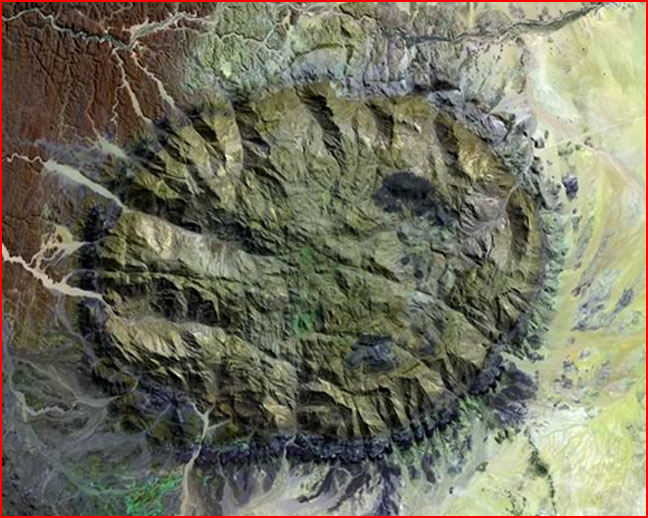
home •
about •
essential guide •
picture of the day •
thunderblogs •
news •
multimedia •
predictions •
products •
get involved •
contact
picture of the day archive subject index
Image Credit: NASA/USGS
Jun 25, 2007
The Brandberg MassifThe deserts of Namibia hold many unusual geological structures that stretch the imagination and defy conventional explanation. Are electric discharges responsible for their formation?
The continent of Africa reveals a history of violent upheaval and colossal forces. Irrespective of their source, the features that can be found in many places exhibit faults, folds and craters. Conventional theories would place the origin of said features in the distant past and in the lap of continental drift theory and/or plate tectonics. But, do those theories, involving time periods that span billions of years, really tell the tale of what appears to be fresh, relatively unworn geology?
The Brandberg Massif is a circular, dome-shaped structure that rises 2573 meters above the flat plains of Namibia and encompasses an area of 650 square kilometers. Its huge size means that it acts as a “rain shadow”, wringing moisture from the clouds and preventing precipitation in the desert. The monolith is described as being over 120 million years old and the remains of a granitic intrusion that “punched through” the Earth’s crust.
The USGS comments: “The mountain's volcanism has long since stilled, but the granite core left behind apparently glows red in the light of the setting sun. The formation is a remnant of a long period of tumultuous volcanic and geologic activity on Earth during which the southern super-continent of Gondwana was splitting apart.”
Found in the vicinity of the Brandberg Massif are parallel grooves and ridges that extend for hundreds of miles, Lichtenberg figures covering an enormous area, multiple craters with strange morphology, and dunes that do not move.
Parallel grooves, or striations, abound in the solar system: on Mars, on Venus (the hottest spot), and on Enceladus (a profoundly cold body). If those patterns have been discovered in such various environments, an explanation that includes that variability must be considered.
Lichtenberg figures are named after Georg Christoph Lichtenberg. They form when lightning bolts strike some material on Earth – it can be soil or even human tissue. They have also been generated artificially in blocks of acrylic plastic. Many Lichtenberg figures have been discovered in the south polar region of Mars and have been discussed in previous Thunderbolt Pictures of the Day as Martian Spiders.
Once again, if the topography surrounding the Brandberg Massif – and the Massif, itself – exhibits structural details that have been uncovered on other planets and moons, then the conventional account falls far short of the observations. By describing the birth of the Massif as an event that emerged gradually in the distant past, scientists are neglecting the observational evidence that the formation is, in reality, a fulgamite of titanic proportions that may have formed suddenly.
A fulgamite, or lightning blister, develops when an electric discharge draws material from the surrounding area and compresses it in the center of a spinning electric vortex, leaving a mound-like formation behind. The most notable fulgamite in the solar system, apart from the largest one, Olympus Mons, is probably the “face on Mars.”
Because the Brandberg Massif rests within an area that reflects the action of gigantic electric arcs, it could very well have formed in a breathtakingly short period of time and not in millions of years.
By Stephen Smith
___________________________________________________________________________Please visit our Forum
The Electric Sky and The Electric Universe available now!

|
|

|
EXECUTIVE EDITORS:
David Talbott, Wallace Thornhill
MANAGING EDITORS:
Steve Smith, Mel Acheson
CONTRIBUTING EDITORS: Michael Armstrong, Dwardu Cardona,
Ev Cochrane,
C.J. Ransom, Don Scott, Rens van der Sluijs, Ian Tresman
WEBMASTER: Brian Talbott
Copyright 2007: thunderbolts.info
![]()
home •
thunderblogs •
forum •
picture of the day •
resources •
team •
updates •
contact us

